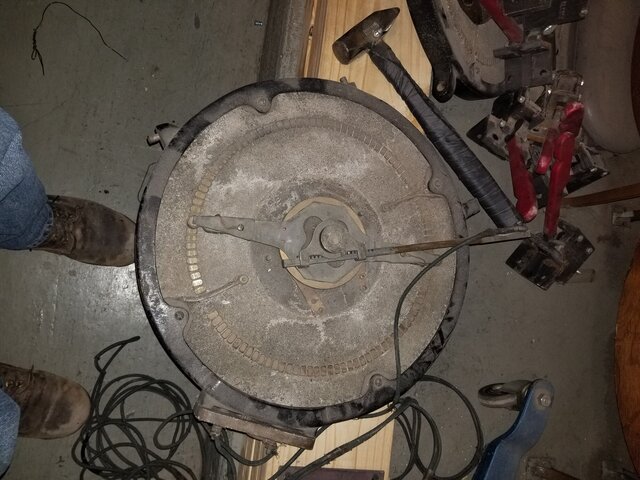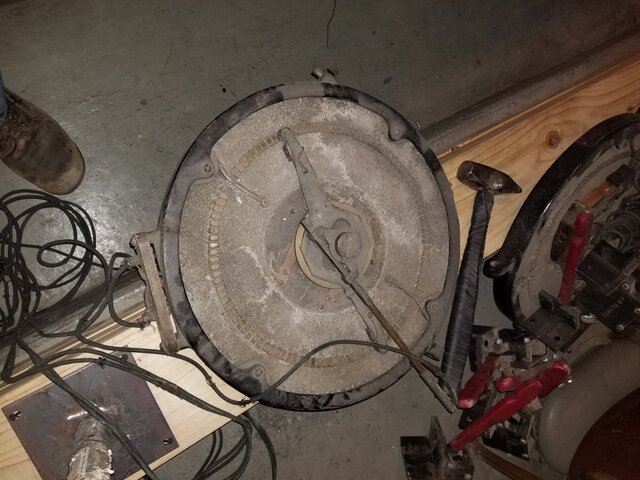Lightning Effect:
No stage lighting books I have specifically mention what I saw & I searched like a 2' stack of them from 1916 thru the 90's. But I’m fairly certain especially with what’s in bold below = completely feasible and only example existing.
The variable resistance dimmer use for this purpose is brilliant (dangerous) in that as opposed to a shorted arc which would blow a fuse or circuit breaker, the resistor part of the dimmer makes it into a carbon arc spotlight ballast or resistor in controlling the otherwise short circuit. Same basic method in doing this as the carbon arc rod with the file method below - but better in that you can adjust how big of a flash you get. Hammer as opposed to carbon arc rod.... interesting. Hammer head shows arching.
The only questionable thing about this is that if the rotary contacts on the old dimmers were hit with a hammer, and you could have larger or smaller lightning bursts dependent on where you struck the resistance dimmer; I would expect to see more damage to them from the hitting and arching. Possibly somewhere else on the dimmer was struck? Given the dimmer voltage adjustment arm is still installed, perhaps they rotated the dimmer arm to the voltage desired and struck the arm somewhere?
Date on them in use for lightning would probably correspond to the mid/late 1950's or around 1970 both years when the 1924 theater lights were replaced with your current stage lights - probably along with some past "new" dimmers for the period in replacing the old ones. This dating theory on the effect because before one of those periods, those dimmers will have still been in use lighting the stage - probably dimming the boarder lights. This dating could also be why no books mention this method. The old dimmers were in use and not surplus for a lightning effect. By the time such dimmers became surplus, such a dangerous method was no doubt more safely done with photo flash lamps in scoops or other methods - except in this theater where some practices were questionable.... So perhaps no books cite this method, but might have been in say "Theater Crafts" or some other trade magazine from the period for the idea.
It is possible both dimmers were used in conjunction to get the 208v arch - one hammer for hitting the opposing phase of power dimmer. Note the two Stage plugs in use and two dimmers wired this way - 30 amps worth of 2-phase 208v arch of lightning potential.
“Lightning more naturalistic than that produced by a projected cut out is created by momentary contacts between a carbon and a metal terminal. This lightning effect, which is offered for sale, is properly enclosed to guard against fire. One type is operated by hand and another is operated by a magnet so that it can be controlled electronically from a distance.” - p.67 Essentials of Stage Lighting, Hunton D. Sellman. New Jersey. Prentice - Hall Inc. 1972.
“4. The old method of using an electrically charged stick of carbon in conjunction with a steel file has been superseded by the above safer options.” - p.109 Lighting the Stage, P.Cory, London. SIR Isaac Pitman & Sons, LTD. 1954.
“A common method of making lightning flashes is by making momentary contacts between a carbon and metal terminal. The operator should be certain that there is some resistance or ballast in the circuit to prevent too much current flowing (see Ch.2). Professionally made lighting flashers are made in this manner and enclosed with a wire screen to prevent fire from sparks. Some of them are magnetically operated for remote control, but they are too noisy unless the thunder is synchronized to cover the contact noise.... - p.285 Stage Scenery and Lighting, Samuel Selden. F.S. Crofts. New York 1940.
The traditional, and most dangerous, way of creating is by rapidly striking and breaking the contacts of an arc. While this method is effective, it is also very dangerous because an arc of sufficient intensity will use 220-volt electricity; and the brilliance (and ultraviolet emissions) of the arc can severely damage the retina of the operator or anyone looking at the contact zone when the arc is made. - p.110 Designing with Light, J. Michael Gillette. Mayfield Publishing Co. California 1989.
Lightning Flashes can be simulated simply by “flashing” the white circuit in the boarder lights on or off. But a far better effect can be secured if real lightning is reproduced, on a small scale, by actually drawing an arc between opposite poles of an electrical circuit. This can be done most simply and most effectively by firmly connecting one wire of a circuit to a large, coarse-tooth, flat file or rasp, and the other wire of the circuit to a short length of carbon (such as used in carbon arc lights). A suitable resistance should be interposed in the circuit to restrict the flow of current to a safe maximum. Both the carbon and the file should be provided with well-insulated handles by which the operator my safely grasp them. When the circuit is alive, the arc may be drawn by lightly touching the file with the tip of the carbon. The arc can then be “trickled” to and fro along the file. With a little practice, lightning flashes can be most realistically simulated in this manner. The process is likely to appear a bit hazardous: the inexperienced operator should wear gloves and should keep his face behind a sheet of red gelatin, which will protect his face from flying sparks and his eyes from the blinding effect of the flash. .... - p.444 Stage Lighting, Theodore Fuchs. Little, Brown & Co. Boston 1929.
Photos TBA.
No stage lighting books I have specifically mention what I saw & I searched like a 2' stack of them from 1916 thru the 90's. But I’m fairly certain especially with what’s in bold below = completely feasible and only example existing.
The variable resistance dimmer use for this purpose is brilliant (dangerous) in that as opposed to a shorted arc which would blow a fuse or circuit breaker, the resistor part of the dimmer makes it into a carbon arc spotlight ballast or resistor in controlling the otherwise short circuit. Same basic method in doing this as the carbon arc rod with the file method below - but better in that you can adjust how big of a flash you get. Hammer as opposed to carbon arc rod.... interesting. Hammer head shows arching.
The only questionable thing about this is that if the rotary contacts on the old dimmers were hit with a hammer, and you could have larger or smaller lightning bursts dependent on where you struck the resistance dimmer; I would expect to see more damage to them from the hitting and arching. Possibly somewhere else on the dimmer was struck? Given the dimmer voltage adjustment arm is still installed, perhaps they rotated the dimmer arm to the voltage desired and struck the arm somewhere?
Date on them in use for lightning would probably correspond to the mid/late 1950's or around 1970 both years when the 1924 theater lights were replaced with your current stage lights - probably along with some past "new" dimmers for the period in replacing the old ones. This dating theory on the effect because before one of those periods, those dimmers will have still been in use lighting the stage - probably dimming the boarder lights. This dating could also be why no books mention this method. The old dimmers were in use and not surplus for a lightning effect. By the time such dimmers became surplus, such a dangerous method was no doubt more safely done with photo flash lamps in scoops or other methods - except in this theater where some practices were questionable.... So perhaps no books cite this method, but might have been in say "Theater Crafts" or some other trade magazine from the period for the idea.
It is possible both dimmers were used in conjunction to get the 208v arch - one hammer for hitting the opposing phase of power dimmer. Note the two Stage plugs in use and two dimmers wired this way - 30 amps worth of 2-phase 208v arch of lightning potential.
“Lightning more naturalistic than that produced by a projected cut out is created by momentary contacts between a carbon and a metal terminal. This lightning effect, which is offered for sale, is properly enclosed to guard against fire. One type is operated by hand and another is operated by a magnet so that it can be controlled electronically from a distance.” - p.67 Essentials of Stage Lighting, Hunton D. Sellman. New Jersey. Prentice - Hall Inc. 1972.
“4. The old method of using an electrically charged stick of carbon in conjunction with a steel file has been superseded by the above safer options.” - p.109 Lighting the Stage, P.Cory, London. SIR Isaac Pitman & Sons, LTD. 1954.
“A common method of making lightning flashes is by making momentary contacts between a carbon and metal terminal. The operator should be certain that there is some resistance or ballast in the circuit to prevent too much current flowing (see Ch.2). Professionally made lighting flashers are made in this manner and enclosed with a wire screen to prevent fire from sparks. Some of them are magnetically operated for remote control, but they are too noisy unless the thunder is synchronized to cover the contact noise.... - p.285 Stage Scenery and Lighting, Samuel Selden. F.S. Crofts. New York 1940.
The traditional, and most dangerous, way of creating is by rapidly striking and breaking the contacts of an arc. While this method is effective, it is also very dangerous because an arc of sufficient intensity will use 220-volt electricity; and the brilliance (and ultraviolet emissions) of the arc can severely damage the retina of the operator or anyone looking at the contact zone when the arc is made. - p.110 Designing with Light, J. Michael Gillette. Mayfield Publishing Co. California 1989.
Lightning Flashes can be simulated simply by “flashing” the white circuit in the boarder lights on or off. But a far better effect can be secured if real lightning is reproduced, on a small scale, by actually drawing an arc between opposite poles of an electrical circuit. This can be done most simply and most effectively by firmly connecting one wire of a circuit to a large, coarse-tooth, flat file or rasp, and the other wire of the circuit to a short length of carbon (such as used in carbon arc lights). A suitable resistance should be interposed in the circuit to restrict the flow of current to a safe maximum. Both the carbon and the file should be provided with well-insulated handles by which the operator my safely grasp them. When the circuit is alive, the arc may be drawn by lightly touching the file with the tip of the carbon. The arc can then be “trickled” to and fro along the file. With a little practice, lightning flashes can be most realistically simulated in this manner. The process is likely to appear a bit hazardous: the inexperienced operator should wear gloves and should keep his face behind a sheet of red gelatin, which will protect his face from flying sparks and his eyes from the blinding effect of the flash. .... - p.444 Stage Lighting, Theodore Fuchs. Little, Brown & Co. Boston 1929.
Photos TBA.
Attachments
Last edited:




